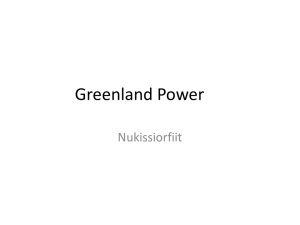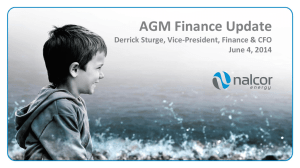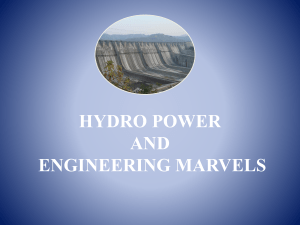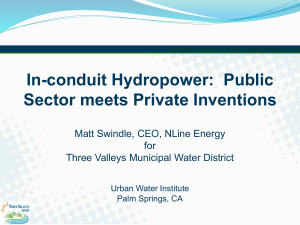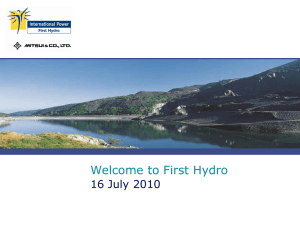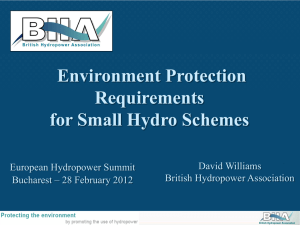Experience of Similar Hydropower Projects in Developing Countries
advertisement
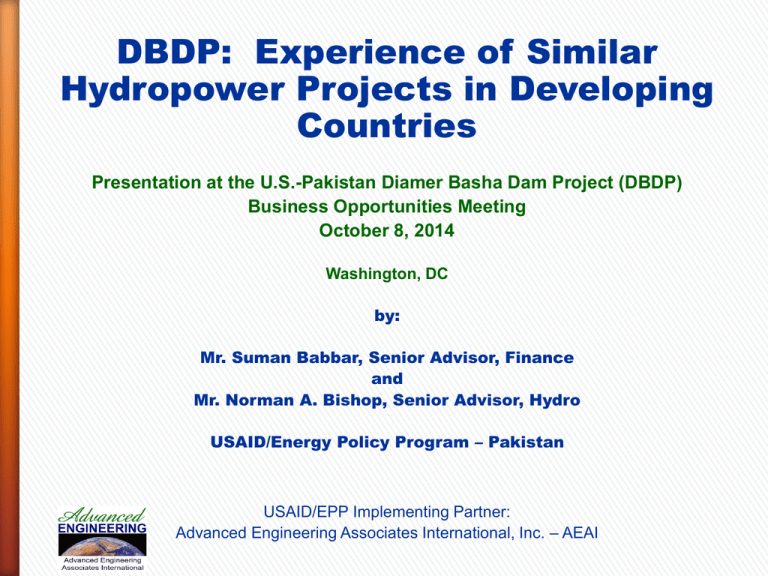
DBDP: Experience of Similar Hydropower Projects in Developing Countries Presentation at the U.S.-Pakistan Diamer Basha Dam Project (DBDP) Business Opportunities Meeting October 8, 2014 Washington, DC by: Mr. Suman Babbar, Senior Advisor, Finance and Mr. Norman A. Bishop, Senior Advisor, Hydro USAID/Energy Policy Program – Pakistan USAID/EPP Implementing Partner: Advanced Engineering Associates International, Inc. – AEAI Presentation Topics • A Look at Similar Large Hydro Projects Constructed and under Construction: Financing Features 1 • Case Studies: Nam Theun 2, Bujagali, Others • Financing of Large Hydro – Key Takeaways • Conclusions and Recommendations: The Way Forward for DBDP 1 Features of World’s Largest Hydro Projects The world’s largest hydro projects (> 4,000 MW) were publicly funded. 2 DBDP &Name Hydro Projects >3,000 MW under Construction Country River Expected Expected Name 3 Country River Installed Completion Yr. capacityMW (MW) Est.completion 1. Baihetan China Jinsha 14,000 2019 2. Belo Monte Brazil Xingu 11,233 2015 3. Wudongde China Jinsha 10,200 2015 4. TaSang Myanmar Salween 7,110 2022 5. Ethiopian Ethiopia Blue Nile 6,000 2018 Renaissance 6. Diamer Basha Pakistan Indus River 4,500 2020 7. Dasu Dam Pakistan Indus River 4,320 2019 8. Jirau Brazil Madeira 3,750 2015 9. Myitsone Myanmar Irrawaddy 3,600 2017 10. Rogun Tajikistan Vakhsh 3,600 2015 11. Santo Antonio Brazil Madeira 3,580 2015 12. Boguchany Russia Angara River 3,000 2013 Dam 13. Guanyinyan China Jinsha 3,000 2015 14. Lianghekou China Yalong 3,000 2015 Some Recent Hydro Projects with PPP Structure 4 . Case Studies Private Sector • Nam Theun 2 Hydropower Project (PDR of Laos) -1070 MW 5 • Bujagali Hydropower Project (Uganda) – 250 MW Others World Energy Council, 2014: Based on public information not validated by the entities. 6 • US$ 1.45 billion, 1070 MW project in Lao PDR • NT2 primarily exports electricity to EGAT of Thailand, with about 5% for domestic use • Original concession awarded in 1993 • Asian financial crisis: project put on hold (1997-2000) • Preparation resumed in 2001 • Due diligence undertaken • About 4 years’ preparation time (2001-2005) • Financial close: June 15, 2005 • Project completed on budget and schedule • Operational since 2010 NT2 - Financial Structure The finance plan comprises 27 financial institutions: • 5 MLAs • 4 ECAs • 2 BLAs • 7 Thai banks • 9 international banks 7 Debt Tenor • USD 16.5 yrs, repayment in 12 yrs • THB 15 yrs, repayment in 10.5 yrs Bujagali Hydropower Project (250 MW) • • • • • • 8 • • • BOOT project on the Nile River in Uganda Run-of-the-river Project cost at approval: US$798 million Debt: Equity ratio of 78:22 leverage Equity: Sithe Global Power - 58%; IPS (Kenya) - 31.5%; Government of Uganda - 10.5% WBG investment: − IFC: $100 million A Loan and up to $30 million C Loan − IDA: $115 million Partial Risk Guarantee (PRG) − MIGA: Up to $115 million MIGA Guarantee Other lenders: EIB, AfDB, Proparco, AFD, DEG, KfW, FMO; commercial banks (Absa Capital, Standard Chartered Bank) under IDA PRG Transmission line: Financed by AfDB and JBIC Formal inauguration: October 8, 2012 Other: Belo Monte – Salient Financing Aspects 9 • 11,233 MW hydro project in Brazil • Limited recourse financing • Energy auction April 2010 – concession awarded to consortium led by Norte Energia • Eletrobras (state-owned utility holding company) the largest shareholder • Financing structure Equity: 20%, Debt: 80% • Equity to be provided by winning consortium • Debt – BNDES loan of $10.8 billion • Completion guarantee by the consortium Other: Three Gorges - Salient Financing Aspects • 1993 –China Three Gorges Corporation created • 1996 - China State Development Bank loan of $3.6 billion 10 • Support from Three Gorges Construction Fund and revenue from Gezhouba Hydro • 2002 – China Yangtze Power Company created • 2003 – IPO by CYPC • ECA support from most of the developed countries and Brazil • Revenue levy dedicated to Three Gorges DBDP: Best Value Analysis Objective • Use Value Engineering (VE) to improve DBDP’s best value for least cost without changing project function (# MW and projected energy): − Reduce costs, schedule and construction risk − Seek project revenues at earliest date to reduce escalation and IDC − Reduce financing cost − Obtain the best overall value for the money spent 11 − Minimize possibility of project budget cost increases Methodology • Analyze each element of the project: VE analysis conducted on each element and its relationship to the precedent element • Cost basis critical path method scheduling: to analyze the cost for each schedule task • A risk assessment performed: to understand how each element or task affects others over time until final project commissioning Financing of Large Hydros: Key Takeaways • In most cases an anchor financier: e.g., ₋ BNDES (Brazilian Development Bank) for large private hydros ₋ World Bank for Dasu 12 • Long tenor funding mobilized • Key role played by Export Credit Agencies • Varied approaches to equity financing • Effective management of social and environmental aspects critical Diamer Basha Dam Project: The Way Forward Key Supporting Factors for Development • GOP fully committed • Strong economic rationale – − Power generation, flood control and irrigation − Improved downstream generation 13 • Ongoing infrastructure development • Existing framework for private sector participation in power generation • GOP open to flexible approach to attract private sector participation during dam construction Conclusions and Recommendations: The Way Forward for DBDP Needs: • A dedicated, qualified implementation team, preferably via a separate corporate entity 14 • Excellent project and construction management team capabilities, experienced in large hydro projects • Compliance with international social & environmental standards Conclusions and Recommendations: The Way Forward for DBDP 15 Needs, cont.: • A clear national financing strategy defined, prioritizing all national infrastructure projects competing with DBDP • Financing advisors with international experience hired • An anchor financier identified • A clearly articulated incentive framework implemented to encourage private participation Thank you! 16 17 Source: The Financing of Water Infrastructure - A Review of Case Studies by Chris Head for The World Bank, 2005

